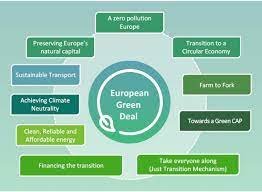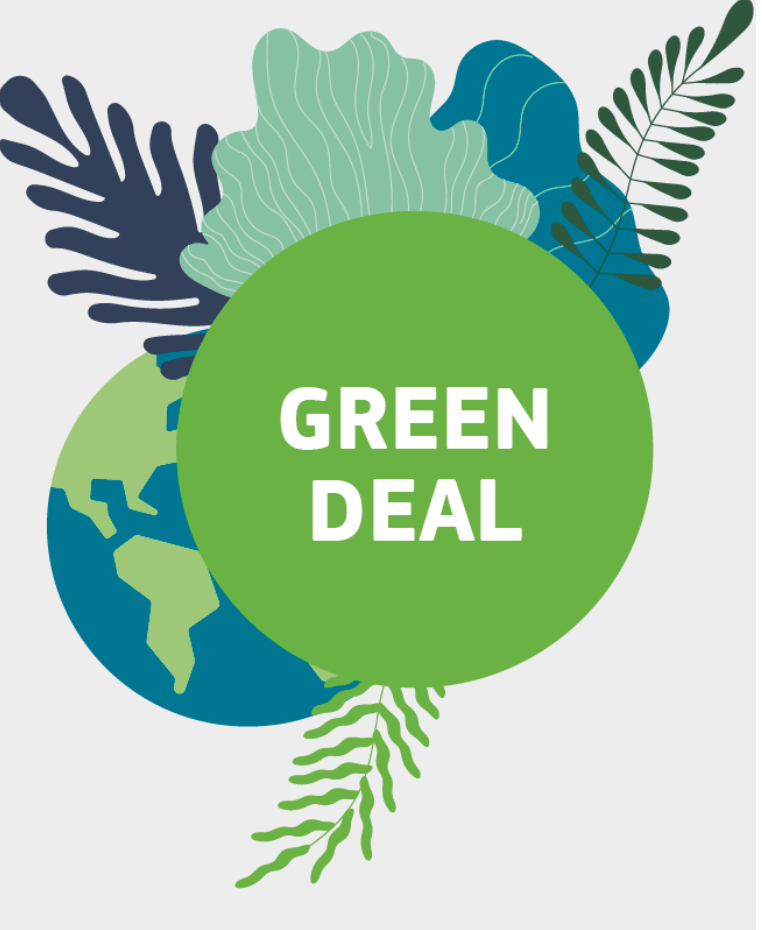Courtesy : en.wikipedia.org
Green deal
The European Green Deal, approved 2020, is a set of policy initiatives by the European Commission with the overarching aim of making the European Union (EU) climate neutral in 2050. An impact assessed plan will also be presented to increase the EU’s greenhouse gas emission reductions target for 2030 to at least 50% and towards 55% compared with 1990 levels. The plan is to review each existing law on its climate merits, and also introduce new legislation on the circular economy, building renovation, biodiversity, farming and innov
The president of the European Commission, Ursula von der Leyen, stated that the European Green Deal would be Europe’s “m Von der Leyen appointed Frans Timmermans as Executive Vice President of the European Commission for the European Green Deal. On 13 December 2019, the European Council decided to press ahead with the plan, with an opt-out for Poland.On 15 January 2020, the European Parliament voted to support the deal as well, with requests for higher ambition.
The European Commission’s climate change strategy, launched in 2020, is focused on a promise to make Europe a net-zero emitter of greenhouse gases by 2050 and to demonstrate that economies will develop without increasing resource usage. However, the Green Deal has measures to ensure that nations that are already reliant on fossil fuels are not left behind in the transition to renewable energy.
Aims
The overarching aim of the European Green Deal is for the European Union to become the world’s first “climate-neutral bloc” by 2050. It has goals extending to many different sectors, including construction, biodiversity, energy, transport and food.
The plan includes potential carbon tariffs for countries that don’t curtail their greenhouse gas pollution at the same rate.The mechanism to achieve this is called the Carbon Border Adjustment Mechanism (CBAM). It also includes:
- a circular economy action plan,The European Commission has released a number of publications on circular economy, including one that requires Member States to carry out activities related to changing their economies into circular economies. The CE has indeed become a key component of the European Green Deal and the Coronavirus Recovery Plan of the Von der Leyen Commission (2019–present), and it was a key component of the Junker Commission’s ambition to create a sustainable, low-carbon, resource-efficient, and competitive economy.
- a review and possible revision (where needed) of the all relevant climate-related policy instruments, including the Emissions Trading System,
- a Farm to Fork strategy along with a focus shift from compliance to performance (which will reward farmers for managing and storing carbon in the soil, improved nutrient management, reducing emissions, …),
- a revision of the Energy Taxation Directive which is looking closely at fossil fuel subsidies and tax exemptions (aviation, shipping),
- a sustainable and smart mobility strategy and
- an EU forest strategy. The latter will have as its key objectives effective afforestation, and forest preservation and restoration in Europe.
It also leans on Horizon Europe, to play a pivotal role in leveraging national public and private investments. Through partnerships with industry and member States, it will support research and innovation on transport technologies, including batteries, clean hydrogen, low-carbon steel making, circular bio-based sectors and the built environment.
The EU plans to finance the policies set out in the Green Deal through an investment plan – InvestEU, which forecasts at least €1 trillion in investment. Furthermore, for the EU to reach its goals set out in the deal, it is estimated that approximately €260 billion a year is going to be required by 2030 in investments.
Before 1970, almost half of all European residential structures were built. At the time, no consideration was given to the amount of energy used by materials and standards. At the present rate of refurbishment, reaching a highly energy-efficient and decarbonised building stock might take more than a century. One of the major aims of the European Green Deal is to “at least double or even triple” the current refurbishment rate of approximately 1%. This is also true outside of the EU. In addition to rehabilitation, investment is required to enable the development of new efficient and ecologically friendly structures.
In July 2021, the European Commission released its “Fit for 55” legislation package, which contains important guidelines for the future of the automotive industry: All new cars sold in the EU must be zero-emission vehicles from 2035.
In the context of the Paris Agreement, and therefore using today’s emissions as baseline, since 1990 EU emissions already dropped by 25% at 2019,a 55% reduction target using 1990 as baseline represents in 2019 terms a 40% reduction target, which can be calculated using this equation:{\displaystyle \left({\frac {0.55-0.25}{1-0.25}}\right)=0.40=40\%}
According to the Emissions Gap Report 2020 by the United Nations Environment Programme, meeting the Paris Agreement’s 1.5 °C temperature increase target (with 66% probability) requires GtCO2e 34/59 = 57% emissions reduction globally from 2019 levels by 2030, therefore well above the 40% target of the European Green Deal.This 57% emission reduction target at 2030 represents average global reductions, while advanced economies are expected to contribute more.






